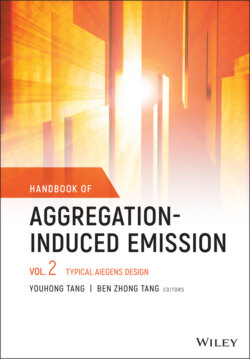Читать книгу Handbook of Aggregation-Induced Emission, Volume 2 - Группа авторов - Страница 28
2.2.1.2 Photochromic Materials
ОглавлениеPhotochromic material refers to a type of material that exhibits the reversible changes of absorption and fluorescence spectra due to the change of molecular structure before and after the light stimulus. In recent years, materials with photochromic properties have been widely concerned by researchers in view of their applications in optical data storage, anti‐counterfeiting, and super‐resolution imaging.
Tian et al. reported a new solid‐state photochromic material 1‐11 (i.e. DSA‐2SP) by covalently linking two spiropyran (SP) moieties to DSA [44] (see Figure 2.3a). As shown in Figure 2.3b, under the stimulation of light and heat, the fluorescence of its powder will change reversibly from yellow to red. Figure 2.3c shows the photoluminescence spectra of 1‐11 (DSA‐2SP) powders before and after UV irradiation. It can be observed that a red‐shifted emission band peaked at 670 nm appeared after UV exposure. They found that the absorption band of conjugated merocyanine (MC) substantially overlaps with the emission band of DSA (see Figure 2.3d), and the distance between the two moieties is only ∼1.463 nm. Therefore, the donor will transfer energy to the acceptor after the UV stimulation. In addition, the twisted DSA itself can not only afford significant free volume for the photoisomerization reaction of SP but also directly form an intramolecular hydrogen bond with the MC to further stabilize the MC form and lead to more efficient photoswitching between DSA‐2SP and its photoisomer DSA‐2MC. Consequently, it was successfully demonstrated that DSA‐2SP is highly applicable as both anti‐counterfeiting inks and super‐resolution imaging agents due to its excellent solid‐state photochromic property (see Figure 2.3b) [44].
